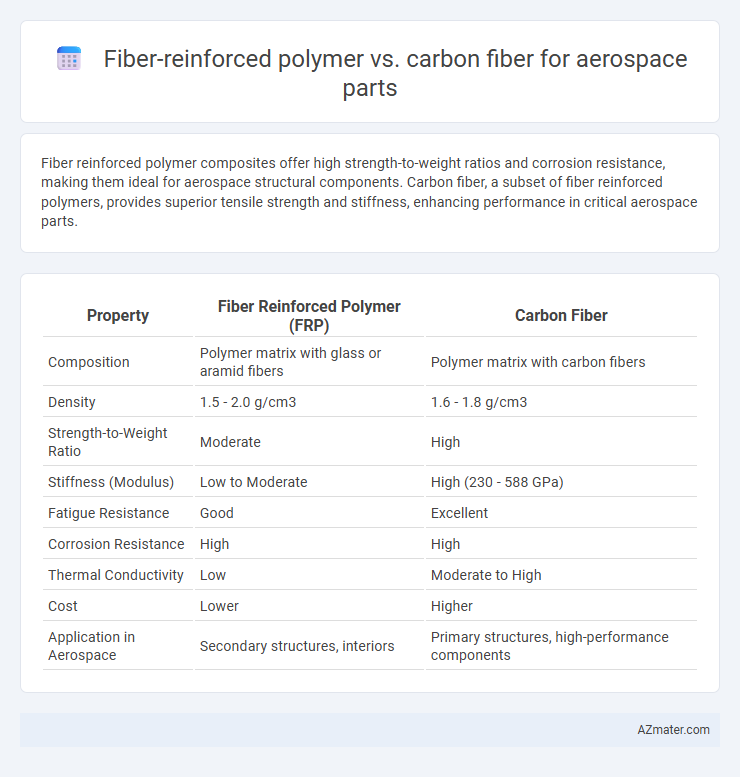Fiber reinforced polymer composites offer high strength-to-weight ratios and corrosion resistance, making them ideal for aerospace structural components. Carbon fiber, a subset of fiber reinforced polymers, provides superior tensile strength and stiffness, enhancing performance in critical aerospace parts.
Table of Comparison
| Property | Fiber Reinforced Polymer (FRP) | Carbon Fiber |
|---|---|---|
| Composition | Polymer matrix with glass or aramid fibers | Polymer matrix with carbon fibers |
| Density | 1.5 - 2.0 g/cm3 | 1.6 - 1.8 g/cm3 |
| Strength-to-Weight Ratio | Moderate | High |
| Stiffness (Modulus) | Low to Moderate | High (230 - 588 GPa) |
| Fatigue Resistance | Good | Excellent |
| Corrosion Resistance | High | High |
| Thermal Conductivity | Low | Moderate to High |
| Cost | Lower | Higher |
| Application in Aerospace | Secondary structures, interiors | Primary structures, high-performance components |
Introduction to Advanced Composite Materials in Aerospace
Fiber reinforced polymer (FRP) and carbon fiber composites are pivotal in aerospace due to their exceptional strength-to-weight ratios, corrosion resistance, and fatigue performance. Carbon fiber composites offer superior stiffness and tensile strength compared to traditional FRP, making them ideal for critical aerospace components requiring high durability and reduced weight. Advanced composite materials like carbon fiber enable significant improvements in fuel efficiency and structural integrity, revolutionizing aircraft design and performance.
Overview of Fiber Reinforced Polymers (FRP)
Fiber reinforced polymers (FRP) are composite materials consisting of a polymer matrix reinforced with fibers such as glass, aramid, or carbon, extensively used in aerospace applications for their high strength-to-weight ratio and corrosion resistance. FRPs offer design flexibility, excellent fatigue resistance, and reduced manufacturing costs compared to traditional metals, making them suitable for structural aerospace components like fuselage panels and wing structures. The choice between glass fiber, aramid fiber, and carbon fiber matrices depends on specific performance requirements, with carbon fiber FRPs delivering superior stiffness and strength critical for high-performance aerospace parts.
Understanding Carbon Fiber Composites
Carbon fiber composites consist of thin carbon filaments bonded with polymer matrices, offering exceptional strength-to-weight ratios critical for aerospace applications. Their superior stiffness, fatigue resistance, and thermal stability outperform traditional fiber reinforced polymers, enabling lightweight yet durable aircraft components. Advanced manufacturing techniques enhance carbon fiber composite versatility, making them ideal for structural parts requiring high performance and reliability in aerospace engineering.
Mechanical Properties: FRP vs Carbon Fiber
Fiber reinforced polymer (FRP) composites offer versatility in mechanical properties, providing good tensile strength, corrosion resistance, and flexibility, making them suitable for various aerospace applications. Carbon fiber composites exhibit superior mechanical properties, including higher tensile strength, stiffness, and lightweight characteristics, which significantly enhance performance and fuel efficiency in aerospace parts. The choice between FRP and carbon fiber depends on specific mechanical requirements, as carbon fiber outperforms FRP in stiffness-to-weight ratio and fatigue resistance critical for aerospace structural components.
Weight Efficiency and Structural Performance
Fiber reinforced polymer (FRP) offers significant weight efficiency advantages over traditional metals, exhibiting high strength-to-weight ratios crucial for aerospace applications. Carbon fiber, a subtype of FRP, delivers superior structural performance with exceptional tensile strength and stiffness, enabling lighter and more durable aerospace parts. The combination of carbon fiber's advanced mechanical properties and FRP's customization flexibility results in optimized aerospace components that balance minimal weight and maximum strength.
Cost Comparison and Economic Considerations
Fiber reinforced polymer (FRP) offers a cost-effective alternative to carbon fiber in aerospace parts, with material and manufacturing expenses generally 30-50% lower, making FRP attractive for large-scale production. Carbon fiber provides superior strength-to-weight ratios and durability but at a premium cost, often exceeding $20 per pound compared to FRP's $8-$12 per pound range. Economic considerations include lifecycle costs, where carbon fiber's longer fatigue life and performance benefits may justify higher upfront investment despite FRP's initial affordability.
Durability and Environmental Resistance
Fiber reinforced polymer (FRP) offers excellent impact resistance and corrosion resistance, making it durable in varied aerospace environments. Carbon fiber, known for its superior strength-to-weight ratio, provides exceptional fatigue resistance and maintains structural integrity under extreme temperature fluctuations. Both materials exhibit high environmental resistance, but carbon fiber composites typically outperform FRP in long-term durability against UV exposure and chemical degradation.
Manufacturing and Fabrication Processes
Fiber reinforced polymer (FRP) and carbon fiber composites differ significantly in manufacturing and fabrication processes for aerospace parts. FRP typically involves simpler lay-up techniques with glass or aramid fibers embedded in a polymer matrix, allowing cost-effective and scalable production, while carbon fiber requires precision-controlled curing cycles and autoclave processing to achieve high strength-to-weight ratios and structural integrity. The advanced manufacturing of carbon fiber composites demands specialized equipment and skilled labor to optimize fiber orientation and resin infusion, resulting in superior mechanical performance but increased complexity and expense compared to FRP.
Typical Aerospace Applications: FRP vs Carbon Fiber
Fiber reinforced polymer (FRP) is commonly used in aerospace for secondary structures such as fairings, interior panels, and non-critical components due to its cost-effectiveness and good strength-to-weight ratio. Carbon fiber composites dominate critical aerospace parts like fuselage sections, wing spars, and engine components because of their superior stiffness, high tensile strength, and lightweight properties. The choice between FRP and carbon fiber depends on performance requirements, with carbon fiber favored for structural integrity and FRP used in applications where lower cost and easier fabrication are priorities.
Future Trends in Aerospace Composite Materials
The future trends in aerospace composite materials emphasize the development of hybrid fiber reinforced polymers combining carbon fiber's high strength-to-weight ratio with the cost-effectiveness and corrosion resistance of traditional fiber reinforced polymers. Advances in nano-engineering and multi-scale reinforcement techniques aim to enhance mechanical properties, thermal stability, and damage tolerance for aerospace parts. Emerging manufacturing methods such as automated fiber placement and additive manufacturing will drive scalability and precision in producing complex composite structures.

Infographic: Fiber reinforced polymer vs Carbon fiber for Aerospace part
 azmater.com
azmater.com